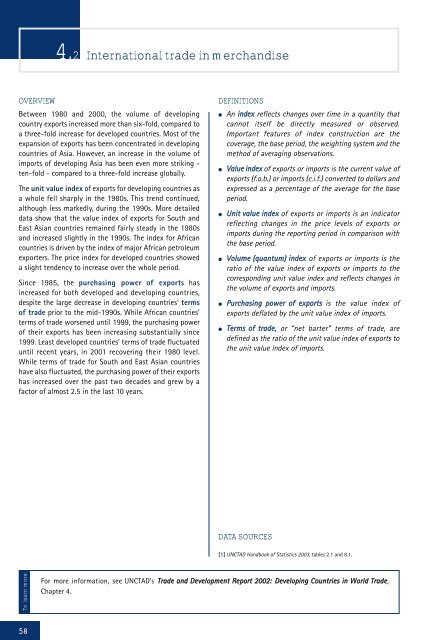Development and Globalization: - Unctad
Development and Globalization: - Unctad
Development and Globalization: - Unctad
Create successful ePaper yourself
Turn your PDF publications into a flip-book with our unique Google optimized e-Paper software.
OVERVIEW DEFINITIONS<br />
Between 1980 <strong>and</strong> 2000, the volume of developing<br />
country exports increased more than six-fold, compared to<br />
a three-fold increase for developed countries. Most of the<br />
expansion of exports has been concentrated in developing<br />
countries of Asia. However, an increase in the volume of<br />
imports of developing Asia has been even more striking -<br />
ten-fold - compared to a three-fold increase globally.<br />
The unit value index of exports for developing countries as<br />
a whole fell sharply in the 1980s. This trend continued,<br />
although less markedly, during the 1990s. More detailed<br />
data show that the value index of exports for South <strong>and</strong><br />
East Asian countries remained fairly steady in the 1980s<br />
<strong>and</strong> increased slightly in the 1990s. The index for African<br />
countries is driven by the index of major African petroleum<br />
exporters. The price index for developed countries showed<br />
a slight tendency to increase over the whole period.<br />
Since 1985, the purchasing power of exports has<br />
increased for both developed <strong>and</strong> developing countries,<br />
despite the large decrease in developing countries’ terms<br />
of trade prior to the mid-1990s. While African countries’<br />
terms of trade worsened until 1999, the purchasing power<br />
of their exports has been increasing substantially since<br />
1999. Least developed countries’ terms of trade fluctuated<br />
until recent years, in 2001 recovering their 1980 level.<br />
While terms of trade for South <strong>and</strong> East Asian countries<br />
have also fluctuated, the purchasing power of their exports<br />
has increased over the past two decades <strong>and</strong> grew by a<br />
factor of almost 2.5 in the last 10 years.<br />
To learn more<br />
58<br />
4.2 International trade in merch<strong>and</strong>ise<br />
● An index reflects changes over time in a quantity that<br />
cannot itself be directly measured or observed.<br />
Important features of index construction are the<br />
coverage, the base period, the weighting system <strong>and</strong> the<br />
method of averaging observations.<br />
● Value index of exports or imports is the current value of<br />
exports (f.o.b.) or imports (c.i.f.) converted to dollars <strong>and</strong><br />
expressed as a percentage of the average for the base<br />
period.<br />
● Unit value index of exports or imports is an indicator<br />
reflecting changes in the price levels of exports or<br />
imports during the reporting period in comparison with<br />
the base period.<br />
● Volume (quantum) index of exports or imports is the<br />
ratio of the value index of exports or imports to the<br />
corresponding unit value index <strong>and</strong> reflects changes in<br />
the volume of exports <strong>and</strong> imports.<br />
● Purchasing power of exports is the value index of<br />
exports deflated by the unit value index of imports.<br />
● Terms of trade, or “net barter” terms of trade, are<br />
defined as the ratio of the unit value index of exports to<br />
the unit value index of imports.<br />
DATA SOURCES<br />
[1] UNCTAD H<strong>and</strong>book of Statistics 2003, tables 2.1 <strong>and</strong> 8.1.<br />
For more information, see UNCTAD’s Trade <strong>and</strong> <strong>Development</strong> Report 2002: Developing Countries in World Trade,<br />
Chapter 4.

















